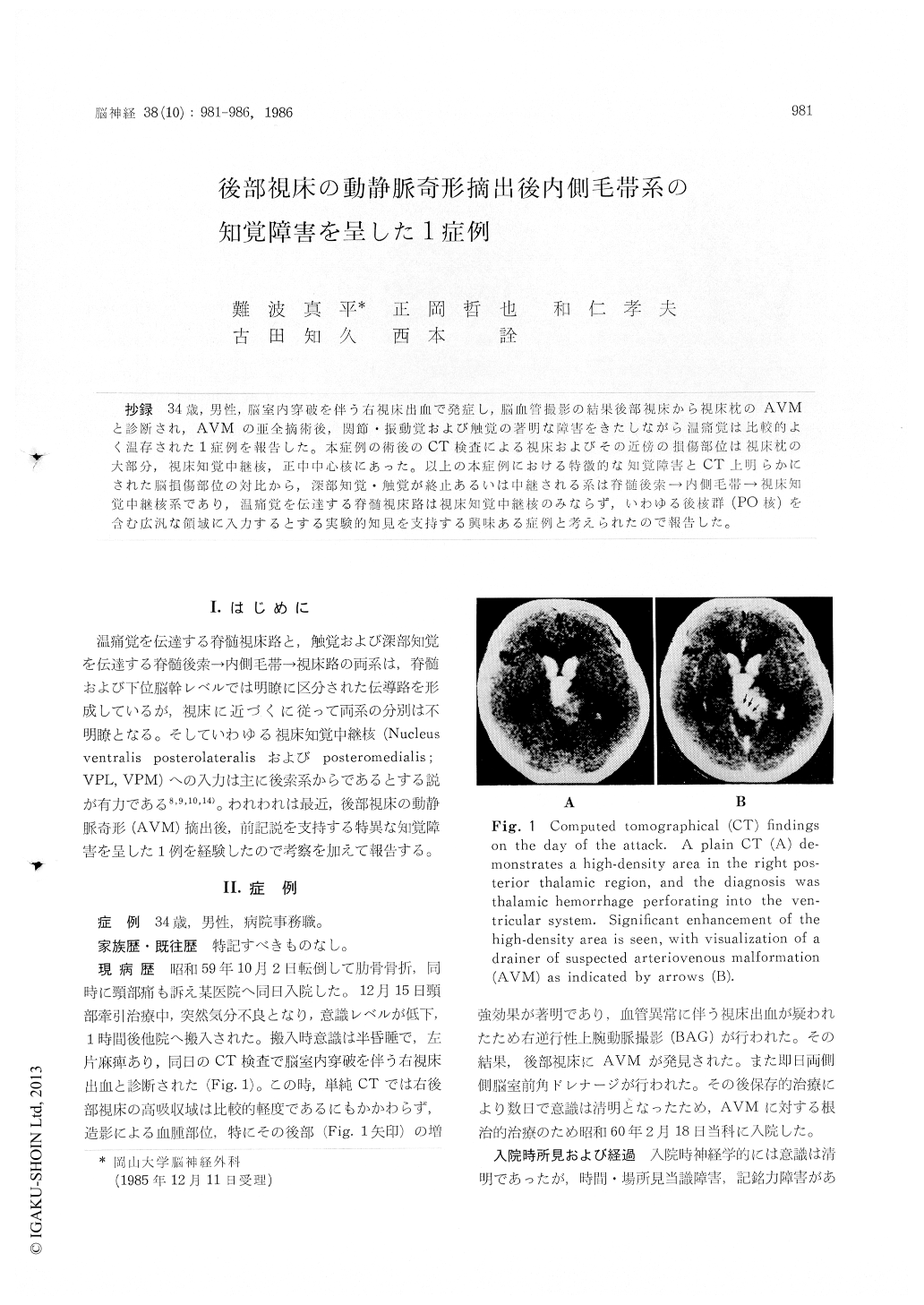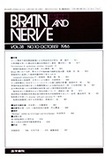Japanese
English
- 有料閲覧
- Abstract 文献概要
- 1ページ目 Look Inside
抄録 34歳,男性,脳室内穿破を伴う右視床出血で発症し,脳血管撮影の結果後部視床から視床枕のAVMと診断され,AVMの亜全摘術後,関節・振動覚および触覚の著明な障害をきたしながら温痛覚は比較的よく温存された1症例を報告した。本症例の術後のCT検査による視床およびその近傍の損傷部位は視床枕の大部分,視床知覚中継核,正中中心核にあった。以上の本症例における特徴的な知覚障害とCT上明らかにされた脳損傷部位の対比から,深部知覚・触覚が終止あるいは中継される系は脊髄後索→内側毛帯→視床知覚中継核系であり,温痛覚を伝達する脊髄視床路は視床知覚中継核のみならず,いわゆる後核群(PO核)を含む広汎な領域に入力するとする実験的知見を支持する興味ある症例と考えられたので報告した。
A-34-year old male developed consciousness dis-turbance ; semicoma, on December 15, 1984, and diagnosed as a thalamic hemorrhage perforating into the ventricular system after a computed tomo-graphical (CT) examination. Angiography reveal-ed an arteriovenous malformation (AVM) in the right posterior thalamic region, which was fed by a posteromedial choroidal artery. He was trans-ferred to our neurosurgical clinic on February 18, 1985. On admission, he was alert, however, dis-orientation and slight mental retardation were seen as well as Parinaud's sign. Mild left hemiparesis was also detected with equivocal hypesthesia on the left lower limb. The AVM was subtotally removed on March 12, via transventricular approach after right parietooccipital craniotomy. Consciousness disturbance (drowsy) and left hemi-plegia developed after the operation, however, these deteriorations were transient, recovering tothe preoperative or better status by 2 weeks after the operation. Postoperative repetitive examina-tions of the sensory perceptibility of various mo-dalities revealed remarkable disturbance or com-plete loss of perception in joint and vibration senses (0-3/10 compared to the healthy left side). Touch sensation was also severely deteriorated (0-3/10) on the affected extremities. The disturb-ances in these modalities of the sensation did not show any trend to improve until the time of dis-charge on 57 th postoperative day. On the other hand, pain and temperature sensations were less remarkably disturbed (5-8/10), and with tendency of gradual improvement. Estimation of the range of lesion by the CT scan with projecting on the Schaltenbrand & Bailey's atlas revealed that the nucleus ventralis caudalis, centre-median nucleus and pulvinar thalami were involved. No sensory evoked potentials were obtained in the affected side.
The most characteristic feature in this case was dissociative sensory disturbance; remarkable in proprioceptive and touch sensations and less re-markable in pain and temperature perceptions. The spinothalamic tract conducting the pain and temperature sensations have been thought to have diverse input, not only into the thalamic sensory nucleus but also in its vicinity such as posterior nuclear group (PO). On the other hand, proprio-ceptive and touch sensations input restrictively into thalamic sensory nuclei via lemniscal system. The dissociation of postoperative sensory disturb-ance seen in this patient was considered to give an important evidence in the human, supporting the experimentally-introduced above mentioned theory.

Copyright © 1986, Igaku-Shoin Ltd. All rights reserved.


